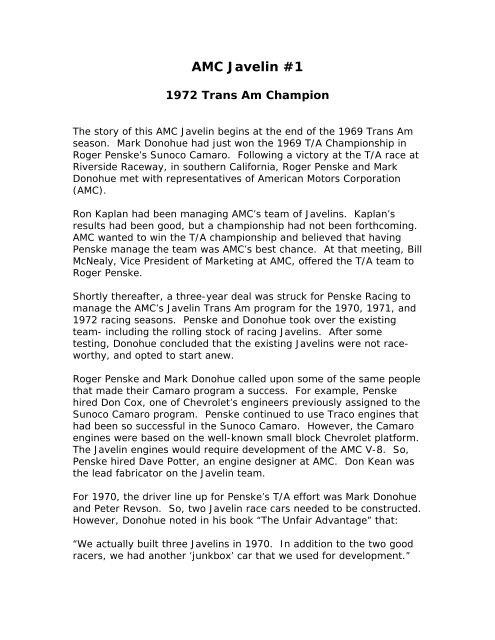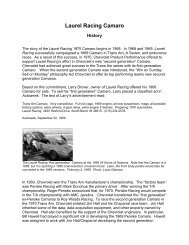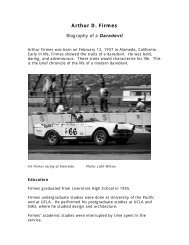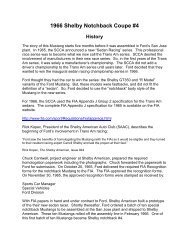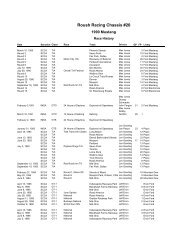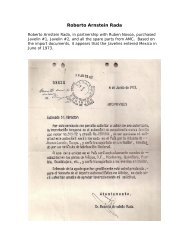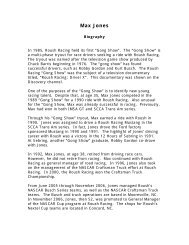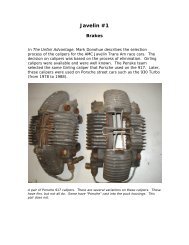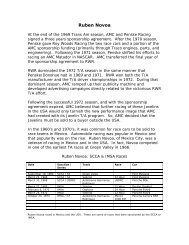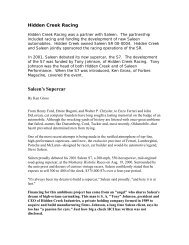You also want an ePaper? Increase the reach of your titles
YUMPU automatically turns print PDFs into web optimized ePapers that Google loves.
<strong>AMC</strong> <strong>Javelin</strong> <strong>#1</strong><br />
1972 Trans Am Champion<br />
The story of this <strong>AMC</strong> <strong>Javelin</strong> begins at the end of the 1969 Trans Am<br />
season. Mark Donohue had just won the 1969 T/A Championship in<br />
Roger Penske’s Sunoco Camaro. Following a victory at the T/A race at<br />
Riverside Raceway, in southern California, Roger Penske and Mark<br />
Donohue met with representatives of American Motors Corporation<br />
(<strong>AMC</strong>).<br />
Ron Kaplan had been managing <strong>AMC</strong>’s team of <strong>Javelin</strong>s. Kaplan’s<br />
results had been good, but a championship had not been forth<strong>com</strong>ing.<br />
<strong>AMC</strong> wanted to win the T/A championship and believed that having<br />
Penske manage the team was <strong>AMC</strong>’s best chance. At that meeting, Bill<br />
McNealy, Vice President of Marketing at <strong>AMC</strong>, offered the T/A team to<br />
Roger Penske.<br />
Shortly thereafter, a three-year deal was struck for Penske Racing to<br />
manage the <strong>AMC</strong>’s <strong>Javelin</strong> Trans Am program for the 1970, 1971, and<br />
1972 racing seasons. Penske and Donohue took over the existing<br />
team- including the rolling stock of racing <strong>Javelin</strong>s. After some<br />
testing, Donohue concluded that the existing <strong>Javelin</strong>s were not raceworthy,<br />
and opted to start anew.<br />
Roger Penske and Mark Donohue called upon some of the same people<br />
that made their Camaro program a success. For example, Penske<br />
hired Don Cox, one of Chevrolet’s engineers previously assigned to the<br />
Sunoco Camaro program. Penske continued to use Traco engines that<br />
had been so successful in the Sunoco Camaro. However, the Camaro<br />
engines were based on the well-known small block Chevrolet platform.<br />
The <strong>Javelin</strong> engines would require development of the <strong>AMC</strong> V-8. So,<br />
Penske hired Dave Potter, an engine designer at <strong>AMC</strong>. Don Kean was<br />
the lead fabricator on the <strong>Javelin</strong> team.<br />
For 1970, the driver line up for Penske’s T/A effort was Mark Donohue<br />
and Peter Revson. So, two <strong>Javelin</strong> race cars needed to be constructed.<br />
However, Donohue noted in his book “The Unfair Advantage” that:<br />
“We actually built three <strong>Javelin</strong>s in 1970. In addition to the two good<br />
racers, we had another ‘junkbox’ car that we used for development.”
The Penske <strong>Javelin</strong>s were constructed from raw chassis’s from <strong>AMC</strong>.<br />
These raw chassis’s are called “Bodies In White”, as they typically are<br />
given a coat of white primer at the factory prior to shipment.<br />
The Sports Car Club of America (SCCA) promulgates the rules for the<br />
Trans Am series and sanctions the races. Initially, in 1966, the SCCA<br />
used Appendix J of the FIA rulebook as the regulations for the newly<br />
created Trans American Sedan Championship. Appendix J limited the<br />
use of parts to those that were manufactured for that make and<br />
model. For example, even though the maximum engine displacement<br />
was 305 cubic inches, the largest Ford engine that was less than 305<br />
c.i. was the 289 c.i. V8. So, Ford entries in the Trans Am series had to<br />
use the 289 c.i. engines and could not update the engine to the<br />
maximum allowable size.<br />
Over time, SCCA relaxed the rules and created greater uniformity. For<br />
example, all cars were allowed to run an engine of the maximum<br />
allowable displacement of five liters, and all cars were allowed to use<br />
the maximum allowable wheel size- even if that wheel size was not<br />
offered by the manufacturer, and even if that wheel required<br />
messaging the fenders to fit. However, the SCCA remained adamant<br />
about the look of the cars (remember T/A was still a manufacturer’s<br />
series). So, changes to the body of the car, other than flared fenders,<br />
were closely scrutinized.<br />
Mark Donohue realized that, for racing, the <strong>Javelin</strong> body was deficient<br />
in some areas. Donohue wanted a taller rear spoiler, a hood with cold<br />
air induction, and the grill moved forward to be flush with the leading<br />
edge of the hood. <strong>AMC</strong> ac<strong>com</strong>modated two of Mark’s requests by<br />
constructing a special Mark Donohue Signature Edition <strong>Javelin</strong> with the<br />
taller rear spoiler and cold air induction. In addition to building the<br />
Signature Edition in the Kenosha, Wisconsin assembly plant, <strong>AMC</strong><br />
made the parts available over-the-counter at the dealerships.<br />
Donohue’s request for the grill to be flush-mounted was implemented<br />
in the 1971 re-styling of the <strong>Javelin</strong>.
1970 Race Season<br />
The first race for the new <strong>Javelin</strong> was at Daytona (a non T/A event).<br />
While the Daytona 24 Hour event was technically a “race”, the Penske<br />
/ Donohue team used it as a test. At Daytona, the plan was to put<br />
many hours on the car, and therefore on its parts, and see which parts<br />
would exhibit excessive wear or fail. The result was indicative of what<br />
was to <strong>com</strong>e for the Penske <strong>Javelin</strong>s. After a few hours, the engine<br />
expired due to oil starvation.<br />
The Penske/Donohue <strong>Javelin</strong> in the hot pit at the 1970 24 Hours of Daytona. Note<br />
the extra driving lights mounted below the front bumper. Lighting has also been<br />
installed on the pit awning and pointed at the <strong>Javelin</strong>. Is that Chris Economaki in the<br />
trench coat?<br />
The first Trans Am race of 1970 was held at Laguna Seca on April 19.<br />
Prior to the race at Laguna, a hose and fitting had been added to the<br />
<strong>Javelin</strong> to allow oil to be added to the engine under pressure. The<br />
connection to the hose was outside the engine <strong>com</strong>partment. At tech<br />
inspection, John Timanus, the tech inspector for the SCCA, noticed the<br />
connection and informed the team that it must be moved inside the<br />
engine <strong>com</strong>partment before the next race.
The Penske Sunoco <strong>Javelin</strong> at Laguna Seca T/A race April 19, 1970. Photo: Dave<br />
Friedman<br />
At Laguna Seca, the engine oiling problems persisted. Penske’s twocar<br />
team broke three engines during practice. During the race at<br />
Laguna, Revson’s <strong>Javelin</strong> retired with brake issues. However,<br />
Donohue’s <strong>Javelin</strong> did finish the race. In fact, Donohue finished just<br />
40 seconds behind the winning Boss 302 driven by rival Parnelli Jones.<br />
The second place finish demonstrated the speed potential of the<br />
<strong>Javelin</strong>- if the oiling problem could be solved.
The “corkscrew” at Laguna Seca during the T/A race. April 1970.<br />
At the fifth race of the 1970 T/A season, the Penske <strong>Javelin</strong> team<br />
made it to the top of the podium. On June 21, a <strong>Javelin</strong>, driven by<br />
Mark Donohue, won the 200 mile event at Bridgehampton, NY. The<br />
victory was cause-for-celebration, and might have saved the <strong>AMC</strong><br />
<strong>Javelin</strong> Trans Am program. However, the victory was achieved under<br />
special circumstances that favored the <strong>Javelin</strong>.<br />
The latter portion of the Bridgehampton race was run in the rain. The<br />
wet racing surface provided a twofold benefit to the <strong>Javelin</strong>s. First, the<br />
wet surface reduced tire traction, which reduced lateral forces on the<br />
oil, and that mitigated the oiling problem. Second, the Penske team<br />
had worked with Goodyear to find an effective rain tire for the <strong>Javelin</strong>.<br />
The Penske team reaped the benefit of that development work at<br />
Bridgehampton where it was obvious that the <strong>Javelin</strong> handled better in<br />
the rain than any of the <strong>com</strong>petitors. The <strong>Javelin</strong>’s rain tires were so<br />
superior to the <strong>com</strong>petition that, after 200 miles, Donohue was two<br />
laps (about 6 miles) ahead of the nearest <strong>com</strong>petitor.
Auto Racing magazine made the <strong>Javelin</strong>’s victory at Bridgehampton the<br />
cover story of the October 1970 issue. Sam Posey wrote an eloquent<br />
article that provides an insider’s view into the Bridgehampton Trans<br />
Am event. A photo of the <strong>Javelin</strong> racing in the rain to victory adorned<br />
the cover of the issue. The caption under the photo reads: “Mark<br />
Donohue’s <strong>Javelin</strong> ends Mustang’s domination of Trans Am”. While the<br />
victory at Bridgehampton did end the domination, the <strong>Javelin</strong> was not<br />
ready to dominate. Engine oiling was still a problem. Dominance for<br />
the <strong>Javelin</strong> would have to wait for the 1971 and 1972 seasons.
Note the caption below the photo of the <strong>Javelin</strong>: “Mark Donohue’s <strong>Javelin</strong> Ends<br />
Mustang’s Domination of Trans-Am”- a prescient remark.<br />
The victory celebration for the Penske/Donohue team was short-lived.<br />
Twelve days later, at Donnybrooke Raceway in Brainerd, Minnesota,<br />
the engine blew up in Donohue’s <strong>Javelin</strong> (#6) in pre-race practice.
Revson gave up his <strong>Javelin</strong> (#9) for Donohue. On July 4, 1970,<br />
Donohue qualified Revson’s <strong>Javelin</strong> third- only 0.9 seconds off the<br />
pole. So, the <strong>Javelin</strong> showed good speed. But, the engine oiling<br />
gremlin returned, and Donohue turned just 14 laps before the engine<br />
expired in the #9 <strong>Javelin</strong>. Donohue’s DNF resulted in a 19 th place<br />
finish in round six of the T/A Championship, which would be his worst<br />
of the season.<br />
At Lime Rock Park, 1970. Photo: Dave Friedman<br />
Oiling issues plagued the <strong>Javelin</strong> engines during the 1970 season. The<br />
Penske/Donohue team mitigated the problem by developing custom oil<br />
pans, and, eventually, a dual oil pump / dual pick up oil system.<br />
Despite the oiling issues, Donohue had a good season. In eleven<br />
Trans Am races, Donohue earned three wins, three seconds, three<br />
thirds, a 13 th , and a 19 th . However, the effort by the Penske/Donohue<br />
team was only good for second in the 1970 T/A Championship.<br />
An internal oil line that some engine builders use to mitigate oiling issues in <strong>AMC</strong><br />
engines.<br />
Mark Donohue worked full time at Penske as an engineer and driver.<br />
In contrast, Peter Revson was hired solely as a driver. Donohue<br />
prepared and set up both <strong>Javelin</strong>s. The set up, according to Donohue,<br />
was identical on both cars. So, the cars were well set up, but perhaps<br />
not well matched to the driving style of Peter Revson. In addition,<br />
since Mark was the number one driver, and Revson number two, if one
<strong>Javelin</strong> developed a mechanical issue, then Donohue would race the<br />
better car. So, while Revson’s results in 1970 were not as good as<br />
those achieved by Donohue, those results are not representative of the<br />
talent that Revson possessed.<br />
Near the end of the 1970 T/A season, Penske and Donohue made two<br />
decisions about the <strong>Javelin</strong> program for 1971: 1) they would build a<br />
new race car from scratch, based on the improved 1971 <strong>Javelin</strong> body,<br />
and 2) they would only have one driver- Mark Donohue. These<br />
decisions led Roger Penske to approach Jerry Schwartz, team manager<br />
of Roy Woods Racing (RWR) at the final race of the 1970 Trans Am<br />
season (RWR campaigned Camaro’s in the 1970 T/A series).<br />
On October 4, 1970, at Riverside Raceway, Roger Penske came to the<br />
RWR paddock and said,<br />
“Jerry, get Roy. I want to talk to both of you in my trailer.”<br />
Roy and Jerry met with Roger and Mark in the Penske trailer. Roger<br />
praised the work that RWR had done in Trans Am and Can Am. In<br />
fact, RWR had been running the ex-Penske 1969 Camaro’s in the<br />
Trans Am series. In particular, Roger was impressed with the<br />
professionalism of the RWR operation. Roger went on to explain the<br />
decisions that he and Mark had made concerning the up<strong>com</strong>ing 1971<br />
Trans Am season.<br />
Roger noted that the side effect of these decisions was that the two<br />
<strong>Javelin</strong>s that Penske raced in 1970 were now available. Penske offered<br />
to give both <strong>Javelin</strong>’s, as well as the spare parts, to RWR, if Roy would<br />
agree to three conditions. Those conditions were:<br />
1) Run the entire 1971 Trans Am season<br />
2) Keep both <strong>Javelin</strong>s in the <strong>AMC</strong> red, white, and blue livery<br />
3) Use the same Traco engines that Penske used<br />
Roy agreed to the first condition, but refused to <strong>com</strong>ply with the latter<br />
two. Roy said that he would paint the <strong>Javelin</strong>s in the RWR signature<br />
yellow with black trim. Further, RWR would continue to use engines<br />
from Al Bartz, of Van Nuys, California.<br />
Penske agreed to the <strong>com</strong>promise. Later, Roy Woods agreed to use<br />
Traco engines. Penske supplied the Traco engines to RWR.
At the conclusion of the Riverside T/A event, the two <strong>Javelin</strong>s from the<br />
1970 season were transferred to Roy Woods Racing (The third Penske<br />
<strong>Javelin</strong>, the “junkbox” <strong>Javelin</strong>, stayed with Penske as a test car.).<br />
Penske retained the sponsorship agreement with <strong>AMC</strong>. However, Roy<br />
Woods Racing and Penske entered into an agreement to share parts,<br />
technology, even Traco engines. In addition, RWR received <strong>AMC</strong><br />
sponsorship from the “American Motors Dealers”.<br />
In 1970, RWR campaigned two 1969 Camaro’s in the Trans Am series<br />
and in SCCA A Sedan races. The two Camaro’s were dressed in RWR’s<br />
signature yellow and black livery and were assigned the numbers 68<br />
and 69. With headquarters in Northridge, California, RWR fell within<br />
the Southern Pacific (SP) Division of the SCCA. In 1970, Roy Woods,<br />
in the #69 Camaro, finished second in A Sedan points in the SP<br />
Division. Based on that finish, Roy was invited to the SCCA<br />
championship race, which, at that time, was known as the American<br />
Road Race of Champions (ARRC).
Prior to installing the 1971 body panels on the 1970 <strong>Javelin</strong>, Roy<br />
changed the number on the <strong>Javelin</strong> to 69- identical to the Camaro that<br />
earned him a spot in the ARRC. In November of 1970, Roy and the<br />
<strong>Javelin</strong> traveled to Road Atlanta, in Georgia, for the ARRC. The A<br />
sedan field at the ARRC included notable Trans Am drivers such as<br />
Warren Tope and Marshall Robbins, as well as the celebrated car<br />
builder, Don Yenko. Roy and the <strong>Javelin</strong> topped them all and became<br />
the 1970 SCCA National Champions.<br />
As soon as Roy and the <strong>Javelin</strong> returned to RWR headquarters, in<br />
southern California, the work to update the <strong>Javelin</strong> to 1971 specs was<br />
begun. Jerry Schwartz, team manager for RWR, recalls the effort to<br />
install the 1971 body panels on the ex-Penske <strong>Javelin</strong>s in this email.
From: Jerry Schwartz<br />
Sent: Thursday, October 03, 2002 2:48 PM<br />
To: Tom G.<br />
Subject: Trans Am Report 2002 Historics<br />
Hi Tom;<br />
I want to tell you how much I enjoyed your excellent Trans Am Report in this issue of<br />
Driven. I am especially fond of the vintage Trans Am cars since I was a Crew Chief on<br />
these cars from 1966 through 1968 for Carroll Shelby and from 1969 through 1983 for<br />
Roy Woods Racing. Trans am in the "Glory Days" was the fiercest, most exciting racing<br />
ever.<br />
I would like to point out one error however, the Ken Epsman <strong>Javelin</strong>, as raced, is a 1972<br />
AMX prepared by Roy Woods Racing (RWR). RWR won the Trans Am Series<br />
Championship in 1972 with George Follmer driving one of the <strong>Javelin</strong>s and Roy drove<br />
the other. The cars were originally 1970 models built by Penske Racing. RWR obtained<br />
the cars at the end of the 1970 season and I was put in charge of re-bodying them with the<br />
'71 bodies. During the re-bodying, we made significant changes. As a result, the only<br />
Penske parts used were the front suspension, part of the cowl/firewall part of the floor<br />
pan and part of the roll cage. The '71 cars were painted yellow and black and were driven<br />
by Peter Revson, Tony Adamowitz and Vick Elford.<br />
For '72, only minor changes were made and painted red, white and blue.<br />
They were great cars and are still my favorites. I can only imagine the thrill it must have<br />
been to <strong>com</strong>pete in that race with all those great old cars.<br />
Sincerely,<br />
Jerry Schwarz<br />
In “The Unfair Advantage”, Donohue describes the process of updating<br />
the <strong>Javelin</strong>s from 1970 to 1971 spec:<br />
“They (RWR) stripped the bodies and updated them to 1971 sheet<br />
metal, and as we developed our new car (the 1971 <strong>Javelin</strong>), we made<br />
all the latest pieces available.”
1971 Race Season<br />
After changing to 1971 body panels, RWR painted both <strong>Javelin</strong> in the<br />
bold yellow and black RWR livery. The cars were numbered 68 and<br />
69.<br />
Both <strong>Javelin</strong>s in the paddock in 1971.<br />
Along with the two <strong>Javelin</strong>s, Roy Woods also got Peter Revson from<br />
Penske Racing. Revson became the number one driver for RWR. Roy<br />
Woods would be the number two driver. However, in April of 1971,<br />
Woods crashed at Riverside Raceway and broke his right foot. Woods<br />
would not be able to drive in the 1971 T/A series.<br />
In an <strong>AMC</strong> press release, Roy Woods, humble about his driving ability,<br />
said:<br />
“Maybe I improved our team’s chances in the Trans Am by breaking<br />
my leg.”
As substitutes, RWR employed three different drivers. During the<br />
1971 T/A season, Revson’s teammates at RWR included: Tony<br />
Adamowicz (T/A Driver of the Year in 1968), Milt Minter, and Vic<br />
Elford. In a conversation at Laguna Seca (August 13, 2010), Tony<br />
Adamowicz recalled that an attempt was made to ac<strong>com</strong>modate Roy’s<br />
broken foot. A large brake pedal, about the size of Roy’s cast, was<br />
fabricated for one of the <strong>Javelin</strong>s. The large pedal did not work for<br />
Roy, but it had unintended benefits. Tony noted that all the RWR<br />
drivers used that car, with the large pedal, to practice left foot braking<br />
(which was not a <strong>com</strong>mon practice at the time).<br />
Tony recalled that he raced the large brake pedal <strong>Javelin</strong>, while Peter<br />
Revson drove the regular pedal car. In addition, Revson preferred a<br />
softer chassis set up than the other drivers, so the cars were set up<br />
differently. The large pedal survives in <strong>Javelin</strong> #2.<br />
Brake pedal of <strong>Javelin</strong> #2. Tony Adamowicz recalled that the large brake pedal was<br />
fabricated to ac<strong>com</strong>modate Roy Woods cast.<br />
The talent did not stop at the drivers. Roy Woods had Jerry Schwartz<br />
as team manager. Previously, Jerry had worked for Shelby American<br />
as lead fabricator. His projects included Shelby race cars such as the<br />
R Model and the Shelby Notchback Trans Am racers. In 1967,<br />
Schwartz was honored with the award for Trans Am Mechanic of the<br />
Year.
Another ex-Shelby associate, Carroll Smith, was chief engineer at<br />
RWR. Bill Eaton, another racing veteran, was chief fabricator. Eaton<br />
and John Ryals worked on the many fabricated parts on the <strong>Javelin</strong>.<br />
John Fort managed the logistics. Frank Martinez, in his first job after<br />
high school, became a race mechanic, and later, a fabricator (he had<br />
some capable mentors). Ron Sampson, Pat McFall, and Doug<br />
Rosenberger handled mechanical duties, as well as fabrication. One of<br />
RWR’s first employees was Mark Waco. Mark still lives close to the<br />
former RWR’s headquarters in Northridge, CA. Tony Hernandez,<br />
formerly with <strong>AMC</strong>, in their racing group, managed the relationships<br />
with sponsors.<br />
The two ex-Penske, now Roy Woods Racing, <strong>Javelin</strong>s at Lime Rock 1971.<br />
Photo: Speed Merchants Collection<br />
For 1971, the SCCA officially recognized that the <strong>AMC</strong> engine had<br />
oiling issues in race conditions. The <strong>AMC</strong> engines were adequate for<br />
the street use for which they were originally intended. However,<br />
running the engines at over 7000 RPM, while braking, accelerating,<br />
and cornering, pushed the engines beyond the design of the oiling<br />
system. Roger Penske convinced the SCCA that a dry sump oiling<br />
system would eliminate the oiling issue and make the <strong>Javelin</strong> a reliably<br />
<strong>com</strong>petitive entry. So, the SCCA allowed the Penske <strong>Javelin</strong> and the<br />
two RWR <strong>Javelin</strong>s to install dry sump oiling systems.
Roy Woods Racing <strong>Javelin</strong> leading the Laurel Racing Camaro at Lime Rock Park,<br />
1971. Photo: Camera 3<br />
As it turned out, Roger was correct, and the SCCA made the right<br />
decision. In 1971, the <strong>AMC</strong> engine would finally be<strong>com</strong>e reliable.<br />
However, for the RWR team, engine reliability did not <strong>com</strong>e<br />
immediately. At the first three T/A events of 1971,Lime Rock Park,<br />
Bryar, and Mid-Ohio, RWR broke four engines. RWR decided to sit out<br />
the fourth event, at Edmonton, Canada, and work on fixing the engine<br />
issues. RWR made progress with the engines, but had still not found<br />
the needed reliability. At Road America, the sixth event of the 1971<br />
T/A series, Vic Elford put his RWR <strong>Javelin</strong> on the front row. However,<br />
an oil pump broke- relegating Elford to a 25 th place finish.
The <strong>Javelin</strong>s of Penske Racing and Roy Woods Racing pace the field at<br />
the second T/A race of 1971 at Bryar. Photo: Bob Karambelas<br />
The seventh event of the ’71 T/A series was contested at Le Circuit<br />
Mount Tremblant, St. Jovite, Quebec. The two RWR <strong>Javelin</strong>s, with<br />
Revson and Milt Minter driving, qualified 3rh and 4 th , respectively.<br />
However, Mintner’s engine lasted only 48 of the 70 laps.<br />
At Watkins Glen, the eighth event of 1971, Revson’s engine spun a<br />
bearing in practice. After changing the engine, Revson was required to<br />
start the race at the back of the field. Revson would drive through the<br />
field to a tenth place finish. Elford in the other <strong>Javelin</strong> would finish<br />
third. Both RWR <strong>Javelin</strong>s finished, and the spun bearing in Revson’s<br />
engine was the last significant engine issue the RWR team would have.<br />
A reunion of the RWR team was held at Sears Point / Infineon<br />
Raceway in Sonoma, CA in May 2009. Many of the original RWR team<br />
members were able to attend. While looking over <strong>Javelin</strong> <strong>#1</strong>, they<br />
noted that the final fix of the oiling problem was a simple one. One of<br />
the braided stainless steel hoses connected to the external oil pump<br />
was routed through the front frame horn. This routing required a<br />
sharp bend in the hose that could reduce its ability to flow oil,<br />
especially when the engine torqued. When the hose was re-routed,<br />
outside the frame horn, the flow increased and the oiling issues<br />
disappeared.<br />
The engine issues that plagued the two <strong>Javelin</strong>s during 1970 and<br />
through seven events of 1971 were behind them. In the final three<br />
races of 1971, both RWR <strong>Javelin</strong>s finished- and finished well. Revson’s<br />
<strong>Javelin</strong> recorded finishes of 9 th , 3 rd , and 1 st (more on this win below).<br />
The other RWR <strong>Javelin</strong> had finishes of 4 th , 4 th , and 2 nd .
Despite the engine reliability troubles that the team experienced, Peter<br />
Revson had a good year as lead driver for RWR. Revson’s best finishes<br />
of the ’71 season were second once, third twice, and fourth once.<br />
While these may not sound like extraordinary results, Mark Donohue<br />
was having amazing success in the Penske <strong>Javelin</strong>. Donohue recorded<br />
seven wins in 1971, so there were not many wins available for the<br />
other <strong>Javelin</strong> team. During 1971, Revson also drove for McLaren in<br />
the Can Am series. Revson dominated that series and won the 1971<br />
Can Am championship. Revson was the first driver born in the USA to<br />
win the Can Am championship.<br />
The ex-Penske <strong>Javelin</strong> in RWR’s yellow and black livery. circa 1971.<br />
Photo: Bill Oursler<br />
The final T/A race of the 1971 season was held at Riverside Raceway<br />
in inland empire area of California. Peter Revson had a scheduling<br />
conflict (Revson was driving in the US Grand Prix F1 race at Watkins<br />
Glen.) and could not race his <strong>Javelin</strong>. T/A series veteran, George<br />
Follmer, was hired by Roy Woods to drive the lead <strong>Javelin</strong>. Vic Elford<br />
would drive the other RWR <strong>Javelin</strong>.<br />
Follmer qualified the <strong>Javelin</strong> on the pole. During the race he led every<br />
lap (except when he brought the <strong>Javelin</strong> in for pit stops). Follmer won<br />
the Riverside T/A race, with teammate Elford in second. Follmer’s win<br />
contributed 9 points to <strong>Javelin</strong>’s season total of 82 and the 1971 Trans<br />
Am manufacturer championship.
Follmer’s victory in the RWR <strong>Javelin</strong> was big news in Wisconsin (<strong>AMC</strong> HQ). The<br />
Milwaukee Sentinel reported the results of all three T/A <strong>Javelin</strong>s. Milwaukee Sentinel<br />
October 4, 1971<br />
Riverside was the first T/A victory for the <strong>Javelin</strong>s under RWR<br />
(Donohue won three T/A races in the car in 1970, and Roy Woods won
the SCCA A Sedan national championship in the car in late 1970.).<br />
More significant, however, it was the beginning of a winning team of<br />
George Follmer and Roy Woods. After the win at Riverside in 1971,<br />
Follmer would stay on in 1972 as lead driver for RWR.<br />
The RWR signature yellow and black livery in 1971. Photo: Bill Oursler<br />
After <strong>Javelin</strong> won the 1971 T/A Manufacturer Championship, <strong>AMC</strong><br />
asked Penske and Donohue to focus on racing <strong>AMC</strong> Matadors in<br />
NASCAR. The 1971 Penske <strong>Javelin</strong> #6 went to Bill Collins. The Penske<br />
“junkbox” test <strong>Javelin</strong> went to the University of Pittsburgh (near<br />
Penske headquarters in Pennsylvania). The final year (1972) of the<br />
three-year sponsorship contract with <strong>AMC</strong> was assigned to Roy Woods<br />
Racing.<br />
With the <strong>AMC</strong> sponsorship contract, RWR changed the livery of the two<br />
<strong>Javelin</strong>s. Gone was RWR’s signature bold yellow and black. For 1972,<br />
the two <strong>Javelin</strong>s returned to the red, white, and blue <strong>AMC</strong> color<br />
scheme that adorned them in 1970 (when the two <strong>Javelin</strong>s were with<br />
Penske). So, things had <strong>com</strong>e full circle for the two <strong>Javelin</strong>s. In 1970,<br />
they were sponsored by the <strong>AMC</strong> factory, were painted <strong>AMC</strong> red,<br />
white, and blue, and had one of the best T/A drivers (Donohue). For<br />
1972, they were once again sponsored (directly) by <strong>AMC</strong>, were in the<br />
<strong>AMC</strong> livery, and had one of the best T/A drivers (Follmer).
George Follmer driving the <strong>#1</strong> <strong>Javelin</strong> at Watkins Glen in 1972.<br />
For 1972, the revolving door for drivers of the second RWR <strong>Javelin</strong> was<br />
gone. Roy Woods was healthy again, and would pilot the second<br />
<strong>Javelin</strong>, with Follmer driving the primary car. Woods gave Follmer’s<br />
<strong>Javelin</strong> the number 1, Woods car carried the number 2.<br />
Woods was a <strong>com</strong>petent race driver (Woods won the 1970 SCCA A<br />
Sedan Championship in the <strong>Javelin</strong>), but humble about his abilities.<br />
He also knew that he had a winner in George Follmer. A RWR press<br />
release noted:<br />
“Roy Woods will be handling the second RWR <strong>Javelin</strong> in Trans Am<br />
<strong>com</strong>petition when it makes an appearance. ‘Most of my time will be<br />
spent as team manager, but I like to keep my hands in driving, too.’”<br />
In early 1972, the SCCA affixed (semi) permanent identification plates<br />
to the Trans Am cars. These identification plates became known as<br />
“Brass Tags”. The <strong>#1</strong> <strong>Javelin</strong> was given Brass Tag 72AS03. The SCCA<br />
tech inspectors riveted these brass tags to the main hoop of the roll<br />
bar. Of course, RWR looked for their “unfair advantage” from the<br />
brass tags. RWR removed the rivets that affixed the brass tags. In<br />
place of the rivets, RWR tapped the holes and inserted screws in place
of the rivets. RWR used the old Penske trick of having one “legal” car<br />
to go through tech inspection and one slightly “illegal” car. The legal<br />
car would go through tech inspection first, and get approved. The ID<br />
of the second, slightly illegal car, would be transferred to the legal car,<br />
and the legal car would be sent through tech again. In that manner,<br />
both the legal and the illegal car would pass tech inspection.<br />
Follmer started the 1972 season just as he finished 1971. The first<br />
race of the ’72 T/A season was contested at Lime Rock Park, and<br />
Follmer won the pole and the race- by two laps!<br />
George Follmer driving the <strong>#1</strong> <strong>Javelin</strong> to a wire-to-wire victory at Lime Rock Park.<br />
June 5, 1972.<br />
At the second T/A race of 1972, at Bryar, New Hampshire, Follmer<br />
again qualified <strong>Javelin</strong> <strong>#1</strong> on the pole. However, at race time, the<br />
battery in <strong>Javelin</strong> <strong>#1</strong> not turn the engine. So, Follmer raced <strong>Javelin</strong><br />
#2, that Roy Woods had qualified. Since the driver of the car had<br />
changed, the SCCA rules required that Follmer start at the back of the<br />
field. Despite the handicapped start, Follmer won the race, but in the<br />
#2 car, not the <strong>#1</strong>.
Roy Woods and George Follmer in the paddock in 1972. Photo: Courtesy of Ken<br />
Epsman.<br />
The third T/A event of the ’72 season was held at the Mid-Ohio Sports<br />
Car Course, in Lexington, Ohio. Follmer was not available to qualify<br />
the <strong>Javelin</strong>. So, John McComb drove <strong>Javelin</strong> <strong>#1</strong> in the qualifying<br />
session. McComb qualified the <strong>Javelin</strong> in 5 th position. However, when<br />
Follmer arrived for the race, T/A rules required George to start the<br />
race last. George worked his way through the field. He set the fastest<br />
race lap chasing down the leader. However, he ran out of laps before<br />
he could take the lead and had to settle for a second place finish.<br />
The fourth T/A race of 1972 was held at the demanding Watkins Glen<br />
track in New York. George dominated the race in <strong>Javelin</strong> <strong>#1</strong>. He set<br />
the fastest race lap and was about to lap the second place car when<br />
the checkers flew.
The beautifully turned out <strong>AMC</strong> sponsored RWR <strong>Javelin</strong> <strong>#1</strong> in 1972. Photo: Barry<br />
Tenin.<br />
George and the <strong>#1</strong> <strong>Javelin</strong> continued their domination of the 1972<br />
season at Donnybrooke Raceway in Brainerd, Minnesota. George<br />
qualified on the pole, set fastest race lap, and won the race.<br />
With the 1972 Trans Am drivers championship in the bag, George<br />
could not race in the final event of the season at Sanair Raceway in<br />
Quebec, Canada (In 1972, George was also racing in the Can Am<br />
series for Roger Penske.). Roy Woods selected Bobby Ferro to drive<br />
<strong>Javelin</strong> <strong>#1</strong>. Ferro was an unusual choice because he was an off-road<br />
racer. In fact, Ferro won the 1972 Baja 500. However, Ferro lived in<br />
Sherman Oaks, California- not far from the Roy Woods Racing<br />
operation in Northridge, California.<br />
The Montreal Gazette reported the driver change:<br />
Bob Ferro makes his first road racing start at Sanair this weekend, taking George<br />
Follmer’s place on the Roy Woods Racing team. Ferro is a two-time winner of the<br />
Baja 500 off-road race and a class winner of the Baja 1000, and was picked up when<br />
Woods saw him in a television program.<br />
The Montreal Gazette, July 28, 1972, Motorsport Column, Chris Allen<br />
In his first time in the <strong>Javelin</strong>, Ferro qualified the car in tenth position.<br />
However, his well-executed qualifying effort was not rewarded. Roy<br />
Woods was concerned with the safety of the track and withdrew both<br />
<strong>Javelin</strong>s. Ferro never got to race <strong>Javelin</strong> <strong>#1</strong>.
Journalist Albert Bochroch reported:<br />
Roy Woods had trucked his two <strong>Javelin</strong>s from California. He had hired Baja winner,<br />
Bob Ferro, to drive in Follmer’s place. He had already qualified his car in the front<br />
row next to pole sitter Warren Tope. And the Ferro <strong>Javelin</strong> was safely in the field in<br />
the fifth row.<br />
But Woods decided that Sanair’s rough surface and battered Armco barriers made<br />
the track unsafe. Pulling out under these circumstances was an especially<br />
courageous act.<br />
The race was a demolition derby…<br />
Only seven of the twenty-seven starters saw the checker. After the race, it was said<br />
someone asked Roy Woods where he bought his crystal ball.<br />
Albert Bochroch, Trans-Am Racing<br />
Jerry Schwartz, RWR Team Manager, noted that:<br />
It was a very dangerous situation, and they did wreck a bunch of cars. Roy was right to pull out.<br />
Email from Jerry Schwartz, May 10, 2010<br />
Bob Ferro returned to off road racing. “Baja Bob” would go on to win<br />
the Baja 500 four times in 1971, 1972, 1974, and 1976. Ferro’s 1974<br />
Baja 500 winning car was prepared by, of course, Roy Woods Racing.<br />
Ferro also won the 1973 Mexican 1000. Bobby Ferro also worked as a<br />
stunt man in movies.<br />
The two <strong>Javelin</strong>s returned intact to RWR headquarters, in California.<br />
Who knows what the destiny of the <strong>Javelin</strong>s would have been if they<br />
had participated in the “destruction derby” at Sanair.<br />
In 1972, Follmer won three races and had one second in <strong>Javelin</strong> <strong>#1</strong>- in<br />
addition to his one victory in the <strong>Javelin</strong> #2. Follmer dominated the<br />
1972 T/A series in a manner similar to Donohue’s ’71 season. Follmer<br />
won the 1972 Trans Am Driver Championship with 95 driver points.<br />
His domination was so thorough that the second place driver had only<br />
60 points. The <strong>AMC</strong> <strong>Javelin</strong> won its second consecutive T/A<br />
Manufacturer’s Championship.<br />
1972 was a storybook year for George Follmer. Follmer <strong>com</strong>peted in<br />
both professional road racing series in the USA: Trans Am and Can<br />
Am. In Can Am, Follmer drove for Penske Racing with teammate Mark
Donohue. In the Penske Porsche 917 Can Am car, George was both<br />
quick and consistent. Follmer’s driving prowess in the scary fast<br />
Porsche 917 earned him the 1972 Can Am drivers championship.
After the victorious 1972 season, SCCA changed the rules of the Trans<br />
Am series. The dominant <strong>AMC</strong> <strong>Javelin</strong>s were instantly obsolete for T/A<br />
racing. <strong>AMC</strong> insisted that the both <strong>Javelin</strong>s be sold to buyers outside<br />
the USA. The theory of this approach is that <strong>AMC</strong>, in general, and the<br />
<strong>Javelin</strong>, in particular, had benefited greatly from the success in the T/A<br />
series. Transferring the <strong>Javelin</strong>s to an amateur racer in the USA might<br />
dull the glow of the success of the <strong>Javelin</strong>s.<br />
So, <strong>AMC</strong> sold both RWR <strong>Javelin</strong>s to a partnership of two racers in<br />
Mexico City. The partners were Ruben Novoa, who had raced in the<br />
Trans Am series, and Roberto Arnstein Rada. Novoa’s initial T/A event<br />
was the 1966 race at Green Valley in a Mustang. In 1968, Novoa<br />
teamed with Fred Van Beuren, again in a Mustang, to run the T/A race<br />
at Sebring. In addition, Novoa was an active Porsche racer in the USA<br />
and in Mexico. In 1972, Novoa finished third in class at the 24 Hours<br />
of Daytona and second in class at the 12 Hours of Sebring in<br />
Porsche’s.<br />
Both <strong>Javelin</strong>s, <strong>#1</strong> and #2, along with two trailers full of spare parts,<br />
went to Mexico. The new owners brought the entire RWR team to<br />
Mexico City to support the <strong>Javelin</strong>s in their first race. Jerry Schwartz<br />
still remembers the incredible hospitality that Novoa and Arnstein<br />
extended to the RWR team.
Roberto Arnstein Rada signed the documents to import <strong>Javelin</strong>s <strong>#1</strong> and #2 into<br />
Mexico. Roberto Arnstein and Ruben Novoa, as partners, purchased both of the<br />
Penske/RWR <strong>Javelin</strong>s.<br />
Document courtesy of Ken Epsman.<br />
In 1973, the Novoa / Arnstein team received sponsorship from Pepsi,<br />
which was convenient for all concerned. The Pepsi colors are similar to<br />
the <strong>AMC</strong> colors, so the <strong>Javelin</strong>s did not have to be repainted. Novoa
was busy campaigning Porsches in World Championship and IMSA<br />
races. So, Novoa hired Michel Jourdain Declercq and one of his<br />
brothers to drive the <strong>Javelin</strong>s. Michel recalls that:<br />
“I drove <strong>Javelin</strong> <strong>#1</strong>. My brother, Jean Pierre (Pio) Jourdain, is the one<br />
that drove <strong>Javelin</strong> #2, when those cars were in Mexico. In the short<br />
races, Pio and I drove the cars. In the endurance races, we shared<br />
the cars with Ruben Novoa and I in one <strong>Javelin</strong> and Pio with Roberto<br />
Arnstein in the other <strong>Javelin</strong> …”<br />
Michel Jourdain driving <strong>Javelin</strong> <strong>#1</strong>, in Pepsi livery. Mexico circa 1973. Photo: Carlos<br />
Eduardo Jalife-Villalon.<br />
The <strong>Javelin</strong> was kept intact. After four years, Ruben Novoa offered to<br />
sell <strong>Javelin</strong> <strong>#1</strong> and the spares. The following advertisement was<br />
placed in the November 3, 1976 issue of Autoweek.<br />
<strong>Javelin</strong> T/A 1972 Champion. Ex Follmer. Mint condition, stored four<br />
years, Completely updated, Ready-to-race, 390 c.i. engine by TRACO,<br />
10 extra MiniLites, Dry and wet tires, gearboxes, gaskets, Many<br />
suspension parts, Windshields, Spare engine, Rear ends, Etc. Too<br />
many spares to list, Enough for four full seasons. Absolutely new.<br />
$17,500<br />
Ruben Novoa
NTE 70 #5916<br />
Mexico City, D.F.<br />
MEXICO<br />
<strong>Javelin</strong> <strong>#1</strong> in the hot pit. Mexico, 1973.<br />
Humberto Esparza, who lived in a suburb of Mexico City, purchased<br />
<strong>Javelin</strong> <strong>#1</strong>. Esparza raced <strong>Javelin</strong> <strong>#1</strong> a few times in Mexico. Michel<br />
Jourdain Declercq racalls that:<br />
“Esparza was not very <strong>com</strong>petitive, and I was hired to drive the car<br />
again. After a few races, the car was parked …”<br />
While Esparza did not continue to race <strong>Javelin</strong> <strong>#1</strong>, he did continue to<br />
enjoy it daily. Esparza displayed the <strong>Javelin</strong> in his living room. After<br />
eleven years, his wife offered the <strong>Javelin</strong> for sale (After over a decade<br />
of putting up with a car in her living room, this should surprise no<br />
one.).
The, slightly deranged, <strong>#1</strong> <strong>Javelin</strong> racing in Mexico City.<br />
Fernando Lozano purchased the <strong>#1</strong> <strong>Javelin</strong>. With the purchase,<br />
Lozano received a portion of the spare parts (originally, two 53 foot<br />
trailers full). Lozano is a fan of <strong>AMC</strong> race cars and of George Follmer,<br />
so he knew what he was getting. Lozano had owned the sister car, the<br />
#2 <strong>Javelin</strong>, from 1976 through 1979. He also still has a Penske<br />
prepared IROC car that was driven by George Follmer.<br />
Some of the spares were used when Lozano hired John Ryals to<br />
recondition the <strong>Javelin</strong> for vintage racing. Ryals was a member of the<br />
RWR team, specializing in fabrication. So, Ryals knew exactly how the<br />
<strong>Javelin</strong> should be set up.<br />
Lozano put the car to use. He participated in vintage events from<br />
1989 through 1992. Lozano recalls with joy that at one vintage event,<br />
at Sears Point International Raceway, he raced the <strong>#1</strong> <strong>Javelin</strong> against<br />
George Follmer in a Bud Moore Boss 302. Lozano’s final vintage race<br />
was at Palm Springs in 1992. Thereafter, Fernando stored the <strong>Javelin</strong><br />
for the three years. In 1995, Fernando decided to sell the <strong>Javelin</strong>.
Fernando Lozano driving <strong>Javelin</strong> <strong>#1</strong> at Sears Point Raceway in 1989.<br />
Fernando lived in Mexico and in California. He kept the <strong>Javelin</strong> in<br />
Jamul, as suburb east of San Diego. Fellow San Diego resident, Craig<br />
Conley, knew that Juan Gonzalez was both a fan of, and friend of,<br />
George Follmer. Craig wrote a letter, dated May 17, 1995, to Juan<br />
Gonzalez describing the <strong>Javelin</strong> and offering it for sale.<br />
Juan Gonzalez was building a car collection at his “Car Amigo”<br />
automobile museum in Dallas, Texas. Juan had hired Gary Van Dam<br />
to acquire and manage the collection. With the help of Craig Conley<br />
and Gary Van Dam, Juan purchased the <strong>Javelin</strong> from Fernando on June<br />
2, 1995.<br />
Gary picked up the <strong>#1</strong> <strong>Javelin</strong> at Fernando’s garage in Jamul, and<br />
transported it directly to John Ryals fabrication shop in southern<br />
California. Gary recalls that when he picked up the <strong>Javelin</strong> it was in<br />
good condition and did not require restoration. Gary noted that the<br />
remaining spare parts were still in the blue Shelby shipping containers.<br />
The <strong>Javelin</strong> had been sitting for some time, so it needed cleaning and<br />
race preparation; otherwise, the <strong>Javelin</strong> did not require significant<br />
reconditioning. For <strong>com</strong>fort and convenience, Gary had a larger racing<br />
seat installed and made the upper, driver side door bar removable.<br />
Remarkably, John Ryals <strong>com</strong>pleted both these tasks, as well as the<br />
race prep, and delivered the <strong>Javelin</strong> to Sears Point in time for the Wine<br />
Country Classic on June 10, 1995.<br />
To prepare the <strong>Javelin</strong>, and Juan’s other cars, for racing, Juan and<br />
Gary hired Dave Cancilla. Gary Van Dam, who has moved to California<br />
and recently was re-united with <strong>Javelin</strong> <strong>#1</strong> at Sears Point, recalls that<br />
he and Dave struggled with the in-line brake booster. After several
attempts to get the boost right, they bypassed the booster. Using just<br />
the brake bias adjuster, they were able to balance the brakes front-torear.<br />
Cars that Mark Donohue raced are displayed at a tribute to Mark Donohue. The cars<br />
displayed represent four Trans Am championships. The 1968 and 1969 Camaro’s<br />
bearing the number 6 won the T/A manufacturer championship in 1968 and 1969,<br />
respectively. The <strong>Javelin</strong> with race number 6 won the T/A championship in 1971.<br />
And, of course, the <strong>#1</strong> <strong>Javelin</strong> is the 1972 T/A champion.<br />
Juan entered the <strong>Javelin</strong> in vintage races on both coasts. In 1996,<br />
<strong>Javelin</strong> <strong>#1</strong> returned to the west coast for the Monterey Historics. Juan<br />
entered the car with none-other-than George Follmer driving. The<br />
following year, 1997, Juan participated in General Racing Ltd.’s Wine<br />
Country Classic. Juan drove the <strong>Javelin</strong> well and finished second,<br />
despite not knowing the difficult Sears Point International Raceway<br />
well. Despite Juan’s success at the Wine Country Classic, he did not<br />
return to the west coast with the <strong>Javelin</strong> until the 1999 Monterey<br />
Historic Automobile Races.<br />
In 2003, the Juan brought the <strong>Javelin</strong> to an SVRA event at Watkins<br />
Glen, NY. Shortly thereafter, Juan decided to sell <strong>Javelin</strong> <strong>#1</strong>. Dave<br />
Cancilla created and placed an advertisement for the <strong>Javelin</strong> in Vintage<br />
Motorsports magazine. The advertisement caught the attention of the<br />
current owner. The <strong>Javelin</strong>, and the spare parts, were kept at Car<br />
Amigo in Dallas, Texas. So, in 2006, a trip to Dallas was arranged.<br />
The spare parts were still in the blue Shelby shipping crates. The<br />
<strong>Javelin</strong> itself was well maintained by Dave Cancilla. Everything<br />
checked out. However, Juan had just sold his ex-George Follmer Boss<br />
302. So, Juan was reconsidering the sale of the <strong>#1</strong> <strong>Javelin</strong>.
At the 2008 Monterey Historic races, at Laguna Seca, George Follmer<br />
approached the current owner and relayed that Juan was ready to sell<br />
the ex-Follmer <strong>#1</strong> <strong>Javelin</strong>. George made the deal happen, and in<br />
December 2008, the sale was <strong>com</strong>pleted.<br />
In March of 2009, the Penske/RWR <strong>Javelin</strong> <strong>#1</strong> returned to the track.<br />
On March 5, the BBC television show and online magazine, Top Gear,<br />
filmed some historic T/A racers at the fabled, and difficult, Sears<br />
Point/Infineon Raceway. The <strong>#1</strong> <strong>Javelin</strong> was filmed on the track using<br />
a camera car just in front of the <strong>AMC</strong>.<br />
The 1971 Penske <strong>Javelin</strong> followed by the Autodynamics Challenger and the Penske /<br />
RWR <strong>Javelin</strong> <strong>#1</strong> during filming for the BBC show Top Gear. Infineon Raceway.<br />
March 5, 2009. Photo: Anton Watts for topgear.<strong>com</strong><br />
The following day, Friday, the <strong>Javelin</strong> was at Thunderhill Raceway, in<br />
Willows California. HMSA held its “Return to the Hill” event that<br />
weekend. A test day was available the day prior to the HMSA event.<br />
This would be the first time that the <strong>Javelin</strong> would run at speed in<br />
many years. The <strong>Javelin</strong> had issues with under steer and a shimmy<br />
under braking. The under steer was fixed by adjusting the panhard<br />
bar. The shimmy is a characteristic of the Penske / RWR <strong>Javelin</strong>s and<br />
can be corrected with alignment.
The passenger side rear shock absorber locked in the fully extended<br />
position, ending the test of the <strong>Javelin</strong>.<br />
The Penske/RWR <strong>Javelin</strong> <strong>#1</strong> in the paddock at Thunderhill Park. HMSA’s Return to<br />
the Hill was <strong>Javelin</strong> <strong>#1</strong>’s first time on the track in many years. March 6, 2009.<br />
Photo: SRS.
The shimmy was attacked by replacing worn spherical bearings in the<br />
lower control arms and by adjusting the alignment. On April 21, 2009,<br />
<strong>Javelin</strong> <strong>#1</strong> ran an HMSA event at Laguna Seca. Again, the car<br />
performed well. However, the shimmy that was experienced at<br />
Thunderhill Park had masked the fact that the brake rotors were<br />
warped. So, there was still some vibration under braking.<br />
The spare parts that came with <strong>Javelin</strong> <strong>#1</strong> included rotors. All four<br />
rotors were replaced and the calipers were rebuilt. A test session at<br />
Sears Point Raceway on May 7, 2009, provided the first vibration-free<br />
stops. However, brake pedal was spongy.<br />
The rear master cylinder was replaced with a similar Girling unit with a<br />
larger bore. The brake balance bar was adjusted from biased toward<br />
the rear to near center.<br />
On May 29, 2009, the <strong>Javelin</strong> participated in General Racing’s Wine<br />
Country Classic. During the practice session on Friday, the rear brakes<br />
were locking up under braking. So, the brake bias was adjusted<br />
further toward the front. This created neutral braking for races on<br />
Saturday and Sunday.<br />
<strong>Javelin</strong> <strong>#1</strong> at the Wine Country Classic. May 30, 2009.<br />
Also participating in the Wine Country Classic were the two other<br />
Penske <strong>Javelin</strong>s. This is the first time that all three Penske <strong>Javelin</strong>s<br />
have been on the track together since 1972.
<strong>Javelin</strong> <strong>#1</strong> followed by the 1971 Penske <strong>Javelin</strong> #6 and the Penske / RWR <strong>Javelin</strong> #2.<br />
Wine Country Classic 2009. Photo: Jimmy Huston.<br />
Both 1972 Roy Woods Racing <strong>Javelin</strong>s nose-to-tail at Infineon. May 2009. Photo:<br />
Jimmy Huston.<br />
<strong>Javelin</strong> <strong>#1</strong> received the honor of appearing on the cover of the July<br />
2009 issue of Vintage Motorsports. Kimball Photography shot a<br />
beautiful suite of photographs that illustrate the feature article about<br />
<strong>Javelin</strong>.
Vintage Motorsports magazine July/August 2009.<br />
On November 12, 2009, The Petersen Automotive Museum hosted a<br />
“Tribute To Trans Am”. George Follmer and members of the Roy<br />
Woods Racing team were honored guests. John Ryal’s, fabricator for<br />
RWR, and southern California resident, entertained the attendees with<br />
stories from “back in the day”. In addition, Ryals brought the Mark<br />
Donohue racing seat that was originally installed by Donohue in <strong>Javelin</strong><br />
<strong>#1</strong> back in 1970. In June of 1995, at the request of Juan Gonzalez,<br />
Ryals had removed the Donohue seat and replaced it with a more<br />
supportive aluminum seat. For the next fifteen years, Ryals safely<br />
stored the seat- waiting to return it to <strong>Javelin</strong> <strong>#1</strong>. At the “Tribute to<br />
Trans Am”, Ryals presented the current owner with the original seat<br />
for <strong>Javelin</strong> <strong>#1</strong>.
Mark Donohue in the “Donohue Seat” in 1970.
The “Donohue Seat” reunited with <strong>Javelin</strong> <strong>#1</strong>. Photo: LHS March, 2010
George Follmer at the Tribute to Trans Am. Petersen Automotive Museum.<br />
November 12, 2009. Photo: Jimmy Huston.<br />
On March 13 and 14, 2010, HMSA presented the inaugural Champions<br />
Grand Prix at Thunderhill raceway. George Follmer was the honored<br />
guest. After a dinner at the track, George spoke of his many and<br />
varied ac<strong>com</strong>plishments in motor racing George’s championshipwinning<br />
<strong>Javelin</strong> <strong>#1</strong> participated in the celebration, as well as a<br />
weekend of racing. The event was covered by the vintage racing<br />
press. George and his <strong>Javelin</strong> received write ups and photo coverage<br />
in Victory Lane and Vintage Motorsports.
<strong>Javelin</strong> <strong>#1</strong> at HMSA’s Champions Grand Prix. March 14, 2010. Photo: Kyle Burt<br />
<strong>Javelin</strong> <strong>#1</strong> was invited to participate in the final Mark Donohue<br />
Reunion at Road America in Elkhart Lake, Wisconsin. The event, held<br />
in July 2010, featured a reunion of Donohue’s co-workers and cars. All<br />
three Penske <strong>Javelin</strong>s made the trip from California to Road America.<br />
The Donohue cars were enthusiastically received by the knowledgeable<br />
Road America fans.
All three Penske <strong>Javelin</strong>s participated in the 2010 Mark Donohue Reunion at Road<br />
America. Photo: Don Lee<br />
In late July 2010, the brake booster was restored. The braking system<br />
was made to function as it was described in Donohue’s book, The<br />
Unfair Advantage. That is, the booster functioned and only added<br />
pressure to the front calipers. The <strong>Javelin</strong> ran several test sessions at<br />
Sears Point, and with some minor adjustments, finally worked well.<br />
In August 2010, <strong>Javelin</strong> <strong>#1</strong> was invited to participate in the inaugural<br />
Monterey Motorsports Reunion. The booster continued to operate<br />
well- perhaps too well. The front brakes were overwhelming the rear<br />
calipers. So, the brake bias was adjusted toward the rear. Balance<br />
was restored, and <strong>Javelin</strong> <strong>#1</strong> performed well.


